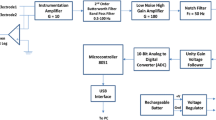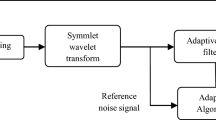Abstract
Two cases of fetal tachycardia are reported: atrial flutter and fibrillation. The waveforms from each case were detected by fetal magnetocardiograms (FMCGs) using a 64-channel superconducting quantum interference device (SQUID) system. Because the magnitude of supraventricular arrhythmia signals is very weak, two subtraction methods were used to detect the fetal MCG waveforms: subtraction of the maternal MCG signal, and subtraction of the fetal QRS complex signal. It was found that atrial-flutter waveforms showed a cyclic pattern and that atrial-fibrillation waveforms showed f-waves with a random atrial rhythm. Fast Fourier transform analysis determined the main frequency of the atrial flutter to be about 7 Hz, and the frequency distribution of atrial fibrillation consisted of small, broad peaks. To visualise the current pattern, current-arrow maps, which simplify the observation of pseudo-current patterns in fetal hearts, of the averaged atrial flutter and fibrillation waveforms were produced. The map of the atrial flutter had a circular pattern, indicating a re-entry circuit, and the map of the atrial fibrillation indicated one wavelet, which was produced by a micro-re-entry circuit. It is thus concluded that an FMCG can detect supraventricular arrhythmia, which can be characterised by re-entry circuits, in fetuses.
Similar content being viewed by others
References
Allessie, M. A., Bonke, F. I. M., andSchopman, F. J. G. (1977): ‘Circus movement in rabbit atrial muscle as a mechanism of tachycardia. III. The ‘Leading circle’ concept: A new model of circus movement of cardiac tissue without the involvement of an anatomical obstacle’,Circ. Res.,41, pp. 9–18
Hamada, H., Horigome, H., Asaka, M., Shigemitsu, S., Mitsui, T., Kubo, T., Kandori, A., andTsukada, K. (1999): ‘Prenatal diagnosis of long QT syndrome using fetal magnetocardiography’,Prenatal Diagnosis,19, pp. 677–680
Horigome, H., Takahashi, M. I., Asaka, M., Shigemitsu, S., Kandori, A., andTsukada, K. (2000): ‘Magnetocardiographic determination of the developmental changes in PQ, QRS and QT intervals in the foetus’,Acta Paediatrica,89, pp. 64–67
Horigome, H., Shiono, J., Shigemitsu, S., Asaka, M., Matsui, A., Kandori, A., Miyashita, T., andTsukada, K. (2001): ‘Detection of cardiac hypertrophy in the fetus by approximation of the current dipole using magnetocardiography’,Pediatr. Res.,50, pp. 242–245
Hosaka, H., andCohen, D. (1976): ‘Visual determination of generators of the magnetocardiogram’,J. Electrocardiol.,9, pp. 426–432
Hosono, T., Chiba, Y., Shinto, M., Miyashita, S., Muramaki, K., Kandori, A., andTsukada, K. (2001a): ‘A case of fetal complete heart block recorded by magnetocardiography, ultrasonography and direct fetal electrocardiography’,Fetal Diagn. Ther.,16, pp. 38–41
Hosono, T., Chiba, Y., Shinto, M., Kandori, A., andTsukada, K. (2001b). ‘A fetal Wolff-Parkinson-White syndrome diagnosed prenatally by magnetocardiography’,Fetal Diagn. Ther.,16, pp. 215–217
Jaeggi, E., Fouron, J. C., andDrblik, S. P. (1998): ‘Fetal atrial flutter: Diagnosis, clinical features, treatment, and outcome’,J. Pediatr.,132, pp. 335–339
Kähler, C., Schleussner, E., Schneider, U., andSeewald, H. J. (2001): ‘Prenatal diagnosis of the Wolff-Parkinson-White-syndrome by fetal magnetocardiogram’,Br. J. Obstet. Gynaecol.,108, pp. 335–336
Kandori, A., Tsukada, K., Horigome, H., Asaka, M., Shigemitsu, S., Takahashi, M. I., Terada, Y., andMitsui, T. (1998). ‘Multichannel SQUID system for detecting fetal magnetocardiogram’. 2nd International Conference on Bioelectromagnetism, pp. 129–130
Kandori, A., Miyashita, T., Tsukada, K., Horigome, H., Asaka, M., Shigemitsu, S., Takahashi, M. I., Terada, Y., andMitsui, T. (1999a): ‘Sensitivity of foetal magnetocardiograms versus gestation week’,Med. Biol. Eng. Comput.,37, pp. 545–548
Kandori, A., Miyashita, T., Tsukada, K., Horigome, H., Asaka, M., Shigemitsu, S., Takahashi, M. I., Terada, Y., andMitsui, T. (1999b): ‘A vector fetal magnetocardiogram system with high sensitivity’,Rev. Scientif. Instrum.,70 (12), pp. 4702–4705
Kandori, A., Kanzaki, H., Miyatake, K., Hashimoto, S., Itoh, S., Tanaka, N., Miyashita, T., andTsukada, K. (2001a): ‘A method for detecting myocardial abnormality by using a total current-vector calculated from ST-segment deviation of a magnetocardiogram signal’,Med. Biol. Eng. Comput.,39, pp. 21–28
Kandori, A., Kanzaki, H., Miyatake, K., Hashimoto, S., Itoh, S., Tanaka, N., Miyashita, T., andTsukada, K. (2001b): ‘A method for detecting myocardial abnormality by using a current-ratio map calculated from an exercise-induced magnetocardiogram’,Med. Biol. Eng. Comput.,39, pp. 29–34
Kandori, A., Miyashita, T., Tsukada, K., Hosono, T., Miyashita, S., Chiba, Y., Horigome, H., Shigemitsu, S., andAsaka, M. (2001c): ‘Prenatal diagnosis of QT prolongation by fetal magnetocardiogram—Use of QRS and T-wave current-arrow maps—’,Physiol. Meas.,22(2), pp. 377–387
Kariniemi, V., Ahopelto, J., Karp, P. J., andKatila, T. E. (1974): ‘The fetal magnetocardiogram’,J. Perinat. Med.,2, pp. 214–216
Koning, K. T., Kirchhof, C. J., Smeets, J. R., Wellens, H. J., Penn, O. C., andAllessie, M. A. (1994): ‘High-density mapping of electrically induced atrial fibrillation in humans’,Circulation,89, pp. 1665–1680
Leuthold, A., Wakai, R. T., andMartin, C. B. (1999): ‘Noninvasive in utero assessment of PR and QRS intervals from the fetal magnetocardiogram’,Early Human Development,54, pp. 235–243
Lewis, T., Feil, H. S. andStroud, W. D. (1920): ‘Observation upon flutter and fibrillation. Part II. The nature of auricular flutter’,Heart,7, pp. 191–245
Menéndez, T., Achenbach, S., Moshage, W., Flüg, M., Beinder, E., Kollert, A., Bittel, A., andBachmann, K. (1998): ‘Pränatale registrierung fetaler Herzakionen mit magnetokardiographie’Z. Kardiolo.,87, pp. 111–118
Menéndez, T., Achenbach, S., Beinder, E., Hofbeck, M., Schmid, O., Singer, H., Moshage, W., andDaniel, W. G. (2000): ‘Prenatal diagnosis of QT prolongation by magnetocardiography’,PACE,23, pp. 1305–1307
More, G. K., Rheinboldt, W. C., andAbildskov, J. A. (1964): ‘A computer model of atrial fibirillation’,Am. Heart J.,67, pp. 200–220
Nakaya, Y., Sumi, M., Saito, K., Fujino, K., Murakami, M., andMori, H. (1984): ‘Analysis of current source of the heart using isomagnetic and vector arrow maps’,Jpn. Heart J.,25(5), pp. 701–711
Rassi, D., andLewis, M. J. (1995): ‘Power spectral analysis of the fetal magnetocardiogram’,Physiol. Meas.,16, pp. 111–120
Soyeur, D. J. (1996): ‘Atrial flutter in the human fetus: Diagnosis, hemodynamics cosequences, and therapy’,J. Cardiovasc. Electophysiol.,7, pp. 989–998
Stambler, B. S., andEllenbogen, K. A. (1996): ‘Elucidating the mechanisms of atrial flutter cycle length variability using power spectral analysis techniques’,Circulation,94, pp. 2515–2525
Van Leeuwen, P., Lange, S., Betterman, H., Grönemeyer, D. H. W., andHatzumann, W. (1999a): ‘Fetal heart rate variability and complexity in the course of pregnancy’,Early Human Develop.,54, pp. 235–243
Van Leeuwen, P., Hailer, B., Bader, W., Geissler, J., Trowitzsch, E., andGrönemeyer, D. H. W. (1999b): ‘Magnetocardiography in the diagnosis of fetal arrhythmia’,Brit. J. Obstet. Gynaecol.,106, pp. 1200–1208
Wakai, T. R., Wang, M., Leuthold, C. A., andMartin, B. C. (1995): ‘Foetal magnetocardiogram amplitude oscillations associated with respiratory sinus arrhythmia’,Physiol. Meas.,16, pp. 49–54
Wakai, T. R., Wang, M., Leuthold, C. A., andMartin, B. C. (1998): ‘Atrial and ventricular fetal heart rate patterns in isolated congenital complete heart block detected by magnetocardiograph’,Am. J. Obstet. Gynecol.,179, pp. 258–260
Wakai, T. R., Lengle, M. J., andLeuthold, C. A. (2000): ‘Transmission of electric and magnetic foetal cardiac signals in a case of ectopia cordis: the dominant role of the vernix caseosa’,Phys. Med. Biol.,45, pp. 1989–1995
Yamada, S., Tsukada, K., Miyashita, T., Noguchi, Y., Ebashi, T., Terada, Y., Kuga, K., andYamaguchi, I. (2001): ‘Analysis of more complex arrhythmias using the tangential components of the cardiac magnetic field’.The 12th International Congress on Biomagnetism, Biomag 2000, pp. 514–517
Author information
Authors and Affiliations
Corresponding author
Rights and permissions
About this article
Cite this article
Kandori, A., Hosono, T., Kanagawa, T. et al. Detection of atrial-flutter and atrial-fibrillation waveforms by fetal magnetocardiogram. Med Bio Eng Comput 40, 213–217 (2002). https://doi.org/10.1007/BF02348127
Received:
Accepted:
Issue Date:
DOI: https://doi.org/10.1007/BF02348127




